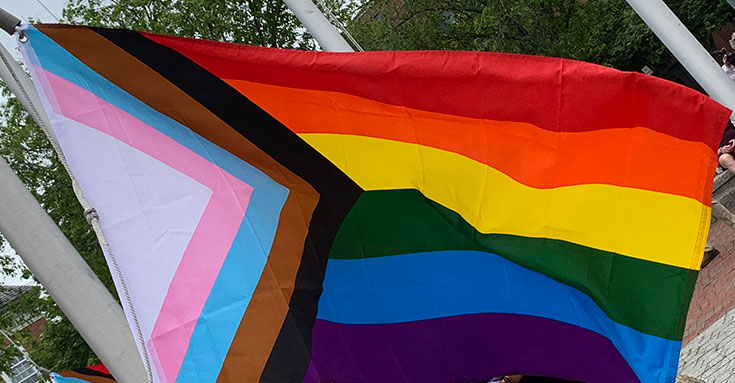When LGBTQ+ Justice Goes Beyond the Rainbow & Why the Progress Pride Flag is Important within that Context; A Look at Recent Developments Within Boston Pride (BP)
By: Nicole Lashomb & Graysen M. Ocasio*/Editor-in-Chief & Publisher, Respectively—
Representation matters. Visibility matters. Inclusion Matters. Progress Matters.
Portland, Oregon-based designer Daniel Quasar gave an inclusive facelift to the original rainbow stripped pride flag in in 2018. His Kickstarter campaign supporting the efforts took off like wild fire with a warm welcome from around the globe. However, the inclusive design to highlight the struggles of the most marginalized within the LGBTQ+ community has also been met with great resistance, especially by some within LGBTQ+ ranks. Still and rightfully so, adoption of the coined “Progress Flag” has been paramount since its inception.
“When the Pride flag was recreated in the last year to include both black/brown stripes, as well as the trans stripes, included this year, I wanted to see if there could be more emphasis in the design of the flag to give it more meaning,” said Quasar in 2018. “The initial idea was important because I felt like I could bring something to the table when it came to the way the flag was shifting within the community. I am a designer and I wanted to make a change where I saw there was an opportunity — a positive change, in my mind at least.”
Intersectionality is not a concept that can continue to be ignored by the mainstream LGBTQ+ community, especially when most major decision-making within pride organizations is centered on the white, cisgender, and gay experience. Pride is not merely a celebration nor “business as usual,” and we shouldn’t pretend otherwise.
The LGBTQ+ community is not monolithic. There are many members of the LGBTQ+ community that are stigmatized, traumatized, and marginalized by society and its own members. The Progress Flag debate is an exclusionary and ironic practice at best.
Pride was a riot lead by Black and Brown trans women and a black lesbian, Stormé DeLarverie who elicited the crowd to action in the middle of her own brutalization by police at the Stonewall Uprising of 1969. Pride and the rainbow flag is not a celebratory pastime. As a community, we must not forget the people who are still fighting for rights, affirmation, acceptance, and recognition. It is incomprehensible to turn our backs on those that need the community the most.
LGBTQ+ organizations that have refused to hear the outcries for inclusion and representation from the Black and Brown, Indigenous, Asian, immigrant, transgender, and women’s communities — and additional further intersectionalities under the rainbow umbrella — have come under fire for their white-centric views and attitudes, serving themselves but not all. A prime example includes the ongoing controversy alleging racist policies and exclusion by the Boston Pride Board of directors. In turn, it has prompted the community to demand the current board relinquishes its responsibilities to new leadership. Based on that premise and disconnect with marginalized LGBTQ+ members, Pride 4 the People was born, The Rainbow Times reported at the time. As of June 9, however, and in a sudden turn of events, Linda DeMarco, Boston Pride president, said to the Boston Globe she would step down.
She told The Globe that her exit plan is “a little accelerated now because I think the boycott is really hurting the community.” But, this isn’t just about DeMarco, but about the whitewashing leadership left behind and the whitewashing LGBTQ+ media in the region being a part of it too.
You cannot claim to understand the struggles of QTBIPOC (and nonbinary PoC) people while sponsoring Boston Pride today or not covering the activism that started back in 2015 when activists halted the Boston Pride Parade for 11 minutes, while Boston Pride called the Boston Police on them. This publication, as the event was unfolding, broke the story while then gladly and professionally sharing it with Bay Windows‘ editor, Sue O’Connell, when she asked for it. For that, The Rainbow Times‘ server almost went down after 10,700 people shared the story online nationwide and even internationally. The activist’s concerns were the same then as they are today. They also went back in 2016 and did the same, in a smaller capacity, but still protested BP for their treatment of trans people and their placement in the parade line (way toward the back, they said to TRT).
And, then Boston Pride joined the St. Patrick’s Day Parade leaving countless loyal people behind, under Sylvain Bruni’s leadership. Nor, can you forget how the same LGBT media (nor Boston Pride, still under Bruni, mentioned an attack on one of their own colleagues) never once covered the explosion on The Rainbow Times‘ newspaper box in downtown Salem in 2016 either, especially when The Rainbow Times is the only LGBTQ+ media in the region owned by minorities (gender, racial and sexual). Not one mentioned the incident, but most mainstream media locally, statewide, nationally, and even internationally did.
That is not what we are about at The Rainbow Times. We are about complete frankness and transparency. In this instance with Boston Pride, pointing fingers only at DeMarco focuses on a white lesbian only, yet many were part of today’s Boston Pride — its evolution and separation with the cause — if they ever truly understood it in the real sense — and without forgetting that many are to blame for its demise, not just DeMarco. We applaud her for stepping down. Others should follow suit too. All LGBTQ+ publications should unbiasedly represent the LGBTQIA+ communities of color, not for gain or tokenism, but to truly and intentionally hire members from our communities to report on our struggles, systemic racism, transphobia, and homophobia that still plagues the most marginalized amongst us, without whitewashing history, erasure, nor “explaining” experiences through the experiences of white people.
It is about the elevating of those voices, not about agreeing with what’s happening or merely reporting on it. It is staying present and being an active part of the change and not a mere “ally” in the passive. The change that we seek is a change that demands equality, that first show us within our communities and own people that you accept us, honor us, respect us, cherish us, and are truly equal toward us. To do that, you must sit in the back and let us lead and let us move this struggle forward, the only way we know how. And, that simply starts with symbols such as the Progress Pride Flag.
According to Quasar, “We need to always keep progress moving forward in all aspects of our community. The main section of the flag (background) includes the traditional 6-stripe LGBTQ flag as seen in its widely adopted form so as not to take away from its original meaning.
“The trans flag and marginalized community stripes were shifted to the Hoist of the flag and given a new arrow shape. The arrow points to the right to show forward movement while being along the left edge shows that progress still needs to be made.”
BLM & BIPOC
The murder of George Floyd sparked a massive international movement toward the demand for racial equity and to end the brutalization of Black and Brown people by the police, amplifying the years-old outcry from the Black Lives Matter movement. Likewise, there are and have been critical calls to dismantle systemic oppression against marginalized communities, a call to end the criminalization of immigrants who’ve come to this country to seek refuge, a call to halt the attempted erasure of trans and non-binary people by every branch of state and federal government and still with trans women of color being murdered at unprecedented rates. The LGBTQ+ mainstream community has a long way to go to create equity and equality in the truest sense of the words for its members. The progress flag serves as a visual reminder of how far we still have to go as a community. We have not yet arrived.
In an interview with them. magazine, Quasar noted that the progress flag is more relevant now than ever.
“The inclusion of the additional stripes means placing emphasis on voices that need to be heard, especially now even more so than two years ago when I originally made the flag,” Quasar said. “Our world is so charged right now and the voices who have been screaming for years are getting louder and louder. We cannot ignore that and must make space for them to be heard. The flag was my way of saying we as a community need to step back and listen.”
Representation Matters
According to the Victory Institute’s Out for America Report, white gay men are most likely the segment of the LGBTQ+ community to be and become elected officials. Nearly 80 percent of openly LGBTQ+ officials are white, 57 percent are gay, and 59 percent are cisgender males. Less than 2% of all LGBTQ+ elected officials are transgender, an extraordinarily disproportionate percentage at best.
“I feel that support for the T in LGBTQ is more talk and less action,” said Danica Roem, then a candidate turned Virginia State Representative, to the Victory Institute. “Everyone that is LGBTQ always says they support the LGBTQ community, but it’s still a struggle to get trans people front and center, and when they are, it seems somewhat disingenuous as they are asked to be there because they have to include everyone.”
Tokenism is not a foreign concept to the trans community, nor BIPOC folks, and is often the case when invited to the table. We’ve seen that occur countless times, especially with self-proclaimed allies.
“When a trans person is running for office, if you claim to be LGBTQ and say you truly support the community, you should be bringing them [trans people] to the table and elevating their voices because that is being truly inclusive and striving to bring us closer to equality,” said Roem to the Victory Institute. “If they fail to do that, I question the statements some make about claiming to be [supportive]. Put your money where your mouth is.”
Surrounding the Trans Day of Visibility, Miss Major Griffin-Gracy, a Stonewall veteran and an activist for trans women of color, explained how visibility could be a double-edged sword for members of the community—especially trans women of color, reported The Rainbow Times.
“I really don’t understand why we need a Day of Visibility since for most of us, especially us black girls, we are as visible as we need to be,” said Miss Major via social media. “Our visibility is getting us killed. So, it’s not that we [trans people] need to be visible. I think the people who care about us, who are involved in our lives, and who know us; they’re the people who need to become more visible. They need to acknowledge that we exist, claim and show that they support us, and the best way to do that is [to] talk about us in a positive light on our day of visibility.”
With a long history of the trans and BIPOC community being excluded, and further stigmatized and sexualized from within and outside the ranks of the LGBTQ+ community, we’ve waited far too long as a broader community to adopt the progress flag as it is.
The American Medical Association recently deemed trans murders an epidemic. With anti-transgender violence being at an all-time high as reported by HRC’s Anti-Transgender Violence Report, “A National Epidemic: Fatal Anti-Transgender Violence in America in 2019”. “Anti-transgender stigma and systemic discrimination heighten the vulnerability of transgender and gender non-conforming people from an early age,” according to the study. The same analysis reported that 91 percent of trans murders were those of trans women of color and 81 percent of them were inflicted upon people under the age of 30.
According to an interview published by the Barnard Center for Research on Women with Miss Major Griffin-Gracy, she further noted that the LGBTQ+ community shuts out transgender folks and people of color.
“I feel like we’ve been pushed to the outside and then prevented from looking in. It’s the stares, the non-inclusion over decision-making, and exclusion from events that would build this movement. I think if they could eradicate us, they would.”
For national trans organizer, activist, author, and inclusion specialist Hope Giselle, being visible can be daunting too,” reported The Rainbow Times.
For trans people of color, as statistics show, visibility can be more perilous.
“If I’m honest, there were times where I was terrified. I have such a vibrant voice, to say the least, and not a lot of folks agree with that,” she told The Rainbow Times. “Social media makes me a sitting duck for bigoted behavior, but I wouldn’t trade it for the world. I believe that I am not just an advocate, but also an activist.”
Army Corporal Laila Villanueva, now medically retired after 12 years of service, agreed and she believes that at this historical time in the world she must overcome the fears — a small price to pay for the work and education that is needed.
“There have been moments when I have feared for my safety because of my visibility, not just as an activist and advocate as a trans woman, but even just as simply being a trans woman of color,” Ireland added. “I recognize that my black trans sisters have a much greater threat to their existence. Being an advocate and activist in this movement in time and generation requires me to look fear in the face and charge head-on with what I believe in fighting for. In many instances for me, remembering the cause of my drive has helped transform that fear into power and positivity moving forward.”
If trans folks and people of color are willing to put themselves on the line for a more just society — where they too are valued within and outside the rainbow — then hoisting a progress flag to visibly represent our most marginalized members, is a minuscule gesture to demonstrate solidarity and visibility for those that have been brutalized and shunned by the mainstream LGBTQ+ movement. To fight against the progress flags’ usage is petty, out of touch with the reality others experience, and privileged at best.
It’s time for progress.
*Nicole Lashomb is the Editor-in-Chief of The Rainbow Times and Co-Ed of Project Out, Inc. She graduated with a BM from the internationally acclaimed Crane School of Music and with an MBA from Marylhurst University. Nicole can be reached at editor@therainbowtimesmass.com.
*Graysen M. Ocasio is the Publisher and at the helm of The Rainbow Times. He is a published writer, veteran journalist, and speaker. He is also the Co-Ed & Founder of Project Out, Inc. and Trans Headlines. He graduated with a Bachelor’s degree in Journalism from Temple University, Philadelphia, PA, and a Master’s of Business Administration from Marylhurst University, Oregon. Graysen can be reached at publisher@therainbowtimesnews.com.







